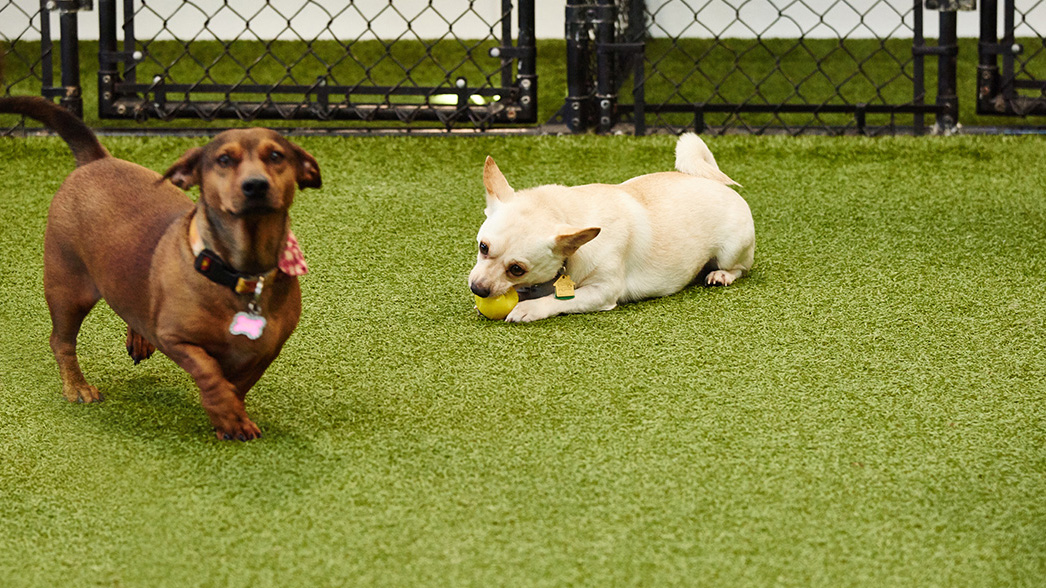
BLOG
UNDERSTANDING YOUR DOG’S BEHAVIOR ISSUES
Merritt Milam | September 30, 2020
Common Misbehavior Problems and How to Help
Dogs will be dogs, but some behaviors need more attention to help control or change a problematic issue like chewing, jumping, or excessive barking. This month we look at a few common behavior issues and offer some helpful tips for managing these problems.
Before we dive deeper into specific behaviors, it is important to note that the first step in solving a problem – is understanding the problem. Once you have a good understanding of your pet’s issue a training plan can be created to help prevent or control the problem.
Destructive Chewing
For young puppies, chewing is a natural way to relieve the pain of incoming teeth. As dogs get older, they chew to keep their teeth healthy and strong. Pets also chew when they become anxious or bored.
But if your dog is chewing in a destructive manner, especially when left alone for long periods of time, they may be trying to deal with separation anxiety. Some dogs may chew or suck on fabric. This may be the result of being weaned too early. (before 7 or 8 weeks of age).
How to Handle Destructive Chewing
If your dog is a young puppy, their teething stage should end around 6 months of age. Beyond this period, chewing activity should be directed to pet approved toys. Make sure the chew toy or bone (inedible) is age appropriate. Most products come with specific warnings, cautioning against leaving the pet alone with their toy or bone. It assures that items don’t become a choking hazard, causing harm to the pet.
Another tip is to dog-proof your home. Make sure valuable items like shoes and clothes are put away from your dog’s curious roaming. It will also help to crate train your pet so they will have a safe place to stay while you are away.
Aggressive Jumper
Dogs learn to jump at an early age when they try to reach or seek the attention of their mother. While jumping begins as a natural response to greeting, it can suddenly become an annoying and even dangerous behavior. Large dogs that constantly jump are at risk of knocking over small children or older adults. Aggressive jumpers will often end up tearing clothing and skin.
How to Handle an Aggressive Jumper
The most common tactic used to keep your dog from jumping is to deny attention to your pet until all four paws on the ground. When the pet jumps, try turning your body away from him/her. Once your pet is sitting, then you can greet and provide praise. It also helps to keep your greeting low key and calm. This will encourage your pet to control excitement, welcoming you and others calmly. It is important to remove the emotion from a greeting with your dog. Using an excited voice and/or pushing them away may only encourage more jumping. From a dog’s perspective, you are sending “play” signals.
Jumping behavior is usually best handled with professional obedience training. Through the use of specific training activities, dogs will learn the sit and stay command, holding their position until released. Mastering these commands are particularly important for dogs who jump or exhibit other types of more aggressive behavior.
Excessive Barking
Barking is a dog’s vocal way to communicate. Whether it’s a bark, howl, or whine, dogs use their voice to relay anger, pleasure, pain, separation anxiety, or curiosity. Barking can be based on territorial issues, greetings, or to sound an alert. Like many behavior issues, when a dog understands they get what they want by barking, the behavior will continue.
How to Handle Excessive Barking
It is important to note that we do not recommend anti-barking collars as a method for controlling excessive barking behavior. These are considered punishment devices. Dogs often learn when not to bark, while the collar is on, and then revert to barking once the collar is taken off. Consistency is important. Don’t punish your dog for barking at a car or kids playing and then reward them for barking when someone knocks on the door.
Seeking support from a professional pet behaviorist may offer the best solution to address excessive barking. Training a dog not to bark and stay quiet. Patience with the process is a must. If your dog is a young puppy, socialization opportunities can help them learn to interact with other people and pets without feeling the need to bark.
What Next?
The behavioral problems mentioned above are just a few of the common issues a pet parent may face with their best friend. Other problems include biting, digging, begging, chasing, and aggression, just to name a few. If your pet is having any of these issues you may want to seek a pet behaviorist or contact our training professional for more help and information.
Please visit our training website page for more information on classes and specific support they can provide to your pet.


